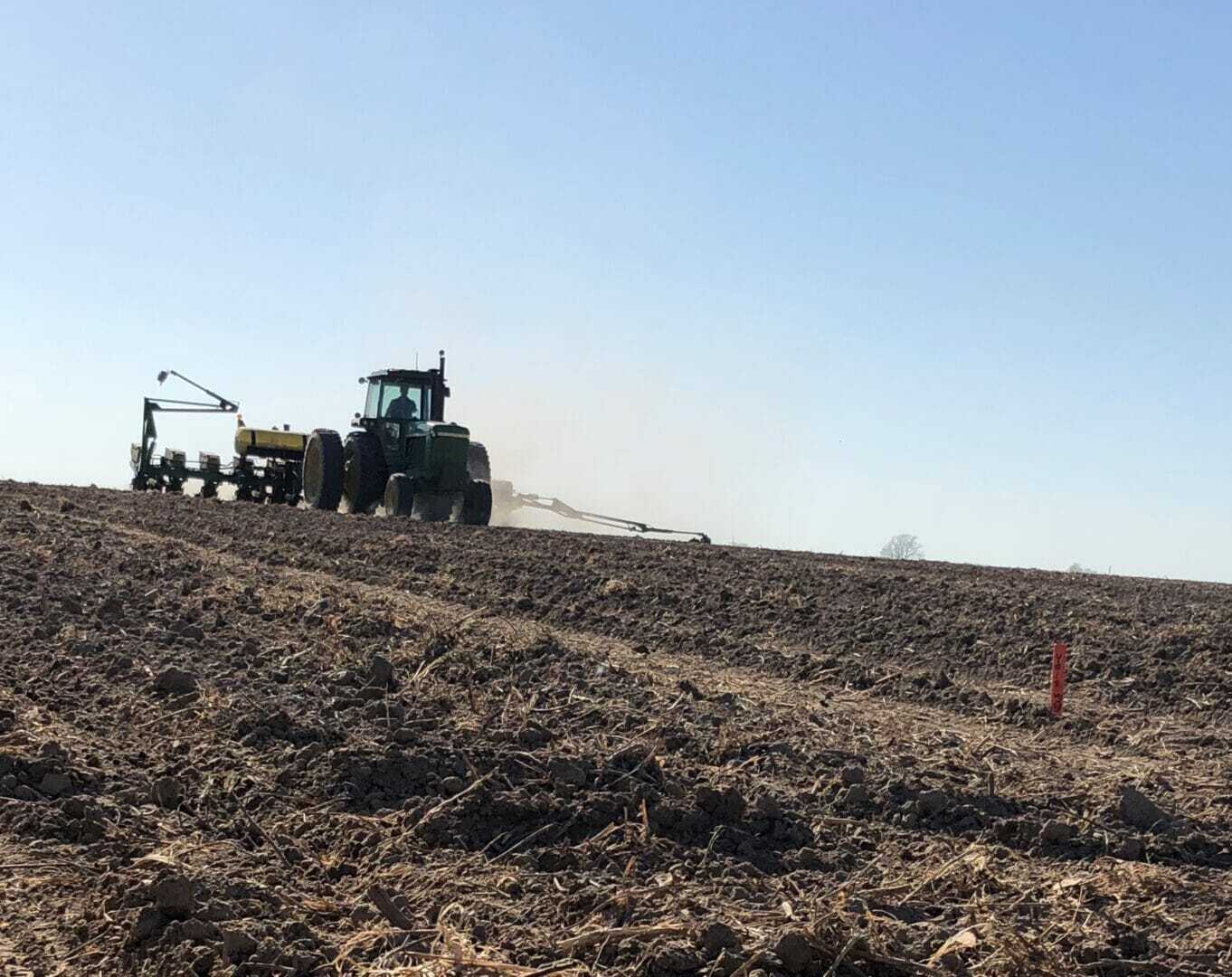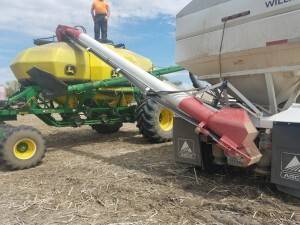With a wet spring across Latham Country, today we discuss sidewall compaction!
For the FB Live link, click here: https://www.facebook.com/LathamSeeds/videos/10156410256102138/

With a wet spring across Latham Country, today we discuss sidewall compaction!
For the FB Live link, click here: https://www.facebook.com/LathamSeeds/videos/10156410256102138/

Jerry Broders
Dave Boeding is planting Latham® seed beans while his grandson Brennen Boeding runs the seed tender.
Bryan Rohe
A good part of Central Iowa has finished or is finishing planting all together. Corn has emerged and is looking good in most fields. Soybeans are just emerging in many fields.
Craig Haaland
Monday we put in a Latham® corn plot in Black Hawk County. Many farmers are already done planting in that area. Further north and into southern Minnesota, however, planting is still at a standstill after 2 to 2.5 inches of rain fell last week. Sunny days are in order for next couple days, so we’re hopeful planting will resume on Thursday or Friday.
Bart Peterson
This field was planted to LH 5279 SS April 27 near Dows, Iowa at a population of 35,000.
Cory Greiman
These photos taken along Highway 69 near Garner, Iowa, sums up the wet spring we’ve experienced so far in northern Iowa and southern Minnesota.
Darin Chapman
It looks like we might get some much needed sunshine for a couple of days Northwest Iowa. There’s also another chance of rain this weekend, so farmers are working to get seed in the ground!
Larry Krapfl
It’s been a wet week in western Iowa and eastern Nebraska, but at least the plot seed that got in the ground is emerging nicely.
Greg Mair
Tuesday we journeyed north to find some dry soils and were able to plant a Latham SuperStrip in Almena, Wisc. The spring weather has been challenging, so only about 40% of the corn and 10% of soybeans planted. I didn’t think planting conditions could ever be more challenging than in 2017, but unfortunately, conditions have been more challenging this spring.
Luckily positive harvest results from 2017 are holding off planters until soil conditions are right. Beautiful weather forecast for this week will get us back on track before more rain moves in this weekend!
Jay Nelson
Field conditions in South Central Minnesota are extremely variable, so planting progress varies. Areas in Renville County are 90% planted on corn and 60% planted on soybeans. Moving a little farther south to Redwood and Brown Counties, fields are only 5% planted on corn and 0% planted on soybeans.
These two photos were literally taken 5 miles apart. You can see where the field in the second photo is just too muddy to get into the field.
Ken Highness
Ryan Skaug of M&R Seed in Beltrami, Minn., on May 15 loads Latham® L 0485 R2 soybeans.
SOUTHEAST SOUTH DAKOTA
Ramie Coughlin
Planting came to a halt last Thursday in South Dakota as rain moved across most of the state. It just picked up again this Tuesday where we able to get our first Latham(R) plot of year in at Estelline, SD. It’s slow going this year, but we are taking advantage of every good day we get.
James Keltgen
Between the showers, cloudy and cool days during the past week, there were some periods of sunshine. Growers in the James River Valley are planting soybeans in full force. To the east, corn is going in quickly where conditions are suitable. Some soybeans also are being planted there. Many growers are working through the night as another 1 to 3 of rain is in the forecast for Thursday night. Because field conditions are already wet, additional rain this week would mean some acres won’t get planted this year.
This photo was taken as we were planting a Latham SuperStrip in Watertown, SD.
Gary Geske
Not all area growers are as lucky as my son, Kyle Geske, who finished planting corn this week. One nice feature of technology like auto steer is that it makes it easier to have “management” check on you. Avery and Carson approve of planting Latham Seed.

Brian McNamee
Steady and unwavering planting progress continues across North Dakota. Several customers are 100% done. As a whole, I would guess we are 75 to 80% planted on corn and 30 to 40% on soybeans. We need rains west and north in the worst way as several farmers are planting into severely dry conditions.
Business is growing at Ideal Seed Solutions in Rugby, ND. To keep up with demand, a new bulk system was built. A a Quickveyor tender was added recently, so they won’t have to handle so many totes next year.

Is it time to switch maturities? Tune in to hear what Phil Long has to say!
Click here: https://www.facebook.com/LathamSeeds/videos/10156393792032138/

Jerry Broders
This customer is finishing up corn planting by Center Point. Most growers in Eastern Iowa are winding down with corn and moving to soybeans.
Bryan Rohe
Soybeans planted early in Central Iowa are confused, which is a sign of imbibitional chilling damage. “Confused seedlings” either emerge incorrectly or not at all because these seeds absorbed water when soil temperatures were less than 55° or 60° F for an extended period of time.
Craig Haaland
Soil temperatures are warm enough for planting, but we received 5 inches of rain last week. Many farmers held off planting when they saw rain was in the forecast, and that turned out to be a good decision for many. After four good days of drying conditions, we had hoped planters would get rolling on Tuesday. Very few soils were dry enough yesterday and then we received another 0.7” last night. We need more drying weather! We need fit soil conditions for best results.
Bart Peterson
This photo was taken on Thursday, May 4, about 4 miles east of Humboldt in West Central Iowa. Total rain fall last week in that area was 4 inches. Due to snow and rain the last two months, farmers in Humboldt County have maybe only 20% of their corn in the ground.
Cory Greiman
We’re seeing signs of winter kill. When alfalfa plants break dormancy, plants are susceptible to cold crown temperatures. Spring snowmelt, combined with late-season snow, may have frozen these plants. Other factors that affect winter kill include: stand age, alfalfa variety, soil pH, soil fertility and cutting management.
Darin Chapman
Northwest Iowa farmers are behind on planting due to continued rainfall. We are looking forward to performing multiple hybrid on-farm research. The photo shows a multi-hybrid and variable rate seeding prescription written with Latham Hi‑Tech Seed’s Data Forward Precision Ag Program. We are able to place two different hybrids (LH 4955 VT2 PRO and LH 5095 VT2 PRO) where they should show best performance on the right soil, at the right seeding rate.
Larry Krapfl
Another field in Western Iowa is being planted with Latham® LibertyLink 3158 soybeans.
Greg Mair
Field conditions in Wisconsin were good for planting lots of acres on Monday and Tuesday. We got two Latham® Corn SuperStrip plots planted: one in Cambridge and another in Watertown. SuperStrip plots are replicated trials of a specific hybrid sets for each maturity range. We use them to evaluate hybrids across Latham Hi‑Tech Seeds’ entire regional footprint to determine field-by-field placement, which helps our customers maximize profit on every acre.
Jay Nelson
According to the latest planting report, corn planting is only 9 percent complete in Minnesota. That’s 9 days behind last year and 16 days behind the 5-year average, making some growers more focused on the calendar date rather than planting conditions. Keep in mind that we’re still well within optimal planting dates, so you can afford to wait for fit soils in order to avoid season-long problems. Wet soils are easily compacted, and sidewall compaction can lead to dramatic decreases in yield.
Ken Highness
May 8 has been our best day this spring in the Red River Valley with a high of 86 degrees! We planted a Latham® SuperStrip plot on the farm of our dealers Mike and Dave Bergquist.
Ramie Coughlin
Fields have finally dried off enough for planters to roll in full force for the past week. We have had some really nice high temperatures and a few very windy days to dry things out nicely. Right now most growers are focusing on corn. A few have planted soybeans, depending on what fields are ready to go. I expect to see a shift to beans start happening within the week.
James Keltgen
Planting is progressing across Northeast South Dakota (NESD). With 4-inch soil temperatures around 49 degrees and the short-term forecast calls for warmer weather ahead, the first Latham SuperStrip went in May 8 at Clark. Growers along the James River Valley are planting in full force. Latham® corn is going in around West River, as well. Some area farmers have finished corn planting and are switching to soybeans. A little corn has been planted around Watertown, but fields here are wetter and are lagging behind. In the Milbank area, growers have been planting soybeans but frost is still coming out of the corn acres.
Gary Geske
Planting depth is crucial for even emergence of seedlings. It’s important that you adjust planters at the beginning of the season – and all season long. As the planting season continues, monitor the settings. You may need to adjust it for every field as field conditions and other variables affect how the planter works. We recommend proper seed selection field-by-field, so it only makes sense to also check planter settings field-by-field.
Brian McNamee
The tractors, seeders and planters keep rolling. Scattered rain showers haven’t slowed down our planting progress. Actually, we could use a rain here. Farmers are chasing planting depth, and we could use more moisture before we continue planting alfalfa. Soybean planting got underway on Monday. We’re providing seed with a smile, right to the field and into the drill!


Tune in for in-field discussion on cover crop spring growth and details on termination!
For the Facebook Live Video, click here: https://www.facebook.com/LathamSeeds/videos/10156377002367138/

Jerry Broders
It’s “Fast and Furious 2018” in Eastern Iowa. Planters are rolling. Plots being planted, so we can collect information that will help us choose Latham’s 2019 lineup.
Bryan Rohe
If you live or farm near Highway 92 in Oskaloosa, you must come look at this Latham® plot by Jackson Seed Sales. We’re showcasing 17 corn hybrids, ranging from 108 to 114 RM. You’ll also see a new 110 day Latham leafy silage corn, plus NemaStrike trials.
Craig Haaland
There isn’t much action in Northern Iowa and Southern Minnesota. Soil temps have been around 34 to 40 degrees Fahrenheit for the past week. Soil temps finally reached the desired 50-degree mark on May 1, and I saw one Mitchell County farmer put some corn in the ground.
Keep in mind the short- and long-range forecasts before planting to avoid chilling effect, which occurs when seed corn takes in cold water. Rain is forecasted for the next couple days. The rain might actually help break up some of this ground that is quite hard now. Hopefully fields will dry out later this week, so planters can be in full force over the weekend.
Bart Peterson
Landon Aldinger, a Latham® dealer in Iowa Falls, Iowa, uses prescription farming equipment to collect data that he uses to select and place seed on a field-by-field basis. Landon started planting on April 30.
Cory Greiman
Our cereal rye cover crop is greening up and growing at my place, south of Garner in North Iowa.
Darin Chapman
With rain in the forecast for Northwest Iowa during the next few days, some farmers are sneaking in field preparation. Frost is still present, so a warm rain may treat us well. Keep in mind that for most of us we can get our entire crop planted within a week, so wait for fit soil conditions and not plant because “the calendar tell us it’s time.” Let’s try to wait for a good window for planting!
Larry Krapfl
This week I helped plant the first corn plot for a Latham customer in western Iowa
Greg Mair
Last Saturday a grower in southern Wisconsin fill his planter with LH 5245 VT2 PRO.
Growers hit the field last Friday and haven’t slowed down since. A much needed rain is expected across much of the area and will likely park planters on Wednesday. Rainfall amounts of up to 4 inches are possible in some areas before Friday evening.
Northern and Central Wisconsin could get planters rolling this weekend, depending on expected rainfall.
Jay Nelson
Warmer temperatures led to melting snow and resulted in 1.3 days suitable for fieldwork during the week ending April 29, 2018, according to USDA’s National Agricultural Statistics Service. Snow has melted in most fields with frost still working its way out of the ground. Farmers who were able to work their fields were busy with field preparation, spreading fertilizer, rock picking and planting.
Now that fields are drying, make sure you check whole field soil temperatures to make sure they’re warm enough to put seed in the ground. Planting is the most crucial time for production, so protect the investment you’ve made.
Ken Highness
Farmers in my region late last week started fieldwork, spreading fertilizer and started seeding. A cold front worked its way through the Red River Valley, and dropped enough rain to shut us down for the day! This picture was taken in Breckenridge, Minn., yesterday where one of our Latham® dealers was taking time for additional maintenance.
Ramie Coughlin
We’re finally getting some field work done. Much of Southeast South Dakota received more rain Monday night, but field work progressed in some areas. The forecast calls for good farming weather in the week to come, so I expect some corn will hit the dirt in the next few days. Please remember, however, it is only the 2nd of May. Plant when conditions are right. It’s not necessary to mud anything in this time of year. If the soil isn’t fit, you’ll see better yields by waiting a few more days to plant.
James Keltgen
After a beautiful week of warmer weather, we’re another day closer to #plant18. Seed deliveries are in full force this week. Planters in Northeast North Dakota are still parked as 4-inch soil temps are only 44 degrees. Soils are starting to dry out, but low spots are still wet and muddy. Frost is starting to come out of the ground, so it’s becoming sponge-like. Growers along Highway 37 are doing some fieldwork. It will most likely be next week before most start planting. We are about one or two weeks behind last year’s progress at this time, but that’s not a problem at this point in the season.
Gary Geske
Planting into cold soils is never good, but we’re planting into cool soils because the forecast looks like temperatures will continue to rise. Protecting the seed is extremely important in this challenging spring. Products like Latham® SoyShield Select™ or SoyShield Plus have multiple fungicides for protection against those early pathogens that attack the young seedling and an insecticide to control the early root nibblers along with early season insect control.
Brian McNamee
After what seemed like two weeks of constant 20-mph winds, our fields have dried out enough for most farmers to get started with spring tillage and crop seeding. I’ve two things as I’ve been driving across the state this week: (1) There is a lot of seed being moved on the roadways; and (2) I cannot remember ever seeing so many fires in the spring. There is a steady hue of smoke from Harvey to Devils Lake as grass fires that stretch for miles. I hear most counties have burn bans in place. From what I’m seeing, the rural fire departments are running steady.
Latham® dealers in North Dakota are doing an excellent job of getting seed in place. Alfalfa is going in the ground, and some people have started planting corn. It’s fast and furious for us this year! Some dealers have expanded their business to better help their customer base. One such example is Heyerdahl Seed Farm where a new soybean bulk system, with high speed treater, was recently built. This will help Heyerdahl customers get the product they need without having to wait in line. It’s looking good!

Jerry Broders
Field work and seed deliveries are heating up just like the temperatures in Eastern Iowa.
Bryan Rohe
Corn planting is underway in Central Iowa. Make sure your planter is set correctly. To maximize yield and to prevent root and stock issues, we recommend planting corn 2.5 inches deep. Soil temps are also very important. Soil temps need to be a minimum of 50 degrees for corn and 60 degrees is recommended for soybeans.
Craig Haaland
How the weather has changed in one week! The 10+ inches of snow we received last week has melted. This work week started with 60-degree temperatures and sunny skies. It looks like more sunshine and warm temperatures are on the way, so seed deliveries are in full force.
As eager as everyone is to get in the field, wait for fit planting conditions. Soil temperature and moisture, plus seed depth and spacing, are key to maximizing yield. Here are a few things to keep in mind before you enter the field:
Bart Peterson
That’s lot of Latham® soybeans! The arrival of warm, spring temperatures means this seed will soon leave the shed.
Cory Greiman
The 4-inch soil temperature was 41° at 7 AM on April 24 at my farm. Temperatures have warmed during the past week, aren’t yet the desired 50° for planting corn.
Darin Chapman
It feels like spring has finally arrived in Northwest Iowa! Although we are eager to get in the field, we must be patient for optimal planting conditions. We want to maximize yield, especially given today’s commodity prices.
Keep in mind that seed corn absorbs soil moisture at less than 50 degrees Fahrenheit, but soil temps must reach 50 degrees or higher for germination. Check out the 5- to 7-day forecast. If soil temperatures are climbing, consider planting corn. If the forecast looks like cold and wet weather for a while, hold off for better conditions. You don’t want seeds to imbibe cold water that can lead to chilling effect or ambient air temperatures to freeze seedlings as they emerge.
Larry Krapfl
Greg Mair
Spring has arrived and there is no turning back! Nice weather has allowed southern Wisconsin farmers to seed alfalfa. The fields worked up nicely on Tuesday for one of our customers in Potosi, who is seeding LH 9120 BR. I expect the corn planters to hit the fields Thursday or Friday.
Jay Nelson
What a difference a week makes! Last week we had 8 to 10 inches of snow on the ground, and now we’re looking at clear fields. This is a picture from same location as the one I posted last week.
Farmers are getting excited. Although the weather warmer is inviting, soil temperatures are still in the low 40s. A few farmers are starting tillage, but it’s not yet fit to as there’s still a lot of frost in the ground.
Ken Highness
This picture was taken April 24 near Glyndon, Minn. Equipment is parked as farmers wait for soils to dry, so planting can begin!
Ramie Coughlin
A week ago most of South Dakota was sitting under a foot or more of snow. During the past week, temperatures really warmed up and we enjoyed some nice days. Today it’s again cold. Rain is falling across most of the state, but at least it’s not snow! Soil temperatures are plenty cool and ground conditions are fairly wet, so no field work is underway.
Farmers in the western counties of Southeast South Dakota may get in the field by the end of this week. We are hoping to get some spring fertilizing started next week in East Central and Southeast South Dakota.
James Keltgen
Mother Nature has finally turned a corner! Temps in the 50s have prevailed for the past week after snow blanketed fields the previous week. Frost is still present at 3.5 feet, so we still have a ways to go before field conditions are ready to plant. ” Soil temperatures are only 37 degrees in Northeast South Dakota. Warmer weather is forecast, so won’t have to wait much longer. Planting will likely start in Central SD and move east as soils dry.
Gary Geske
There’s still a little snow on the ground, but the tile pumps are starting to run. For me, this is the first real sign of spring. Soil temperatures are warming, so soon we will start planting.
Brian McNamee
We have entered a very favorable weather pattern recently. If the long term forecast holds true, we should be able to seed/plant all crops within a steady procession of one another: spring wheat, barley, durum, and all cereal grains followed by field peas and canola followed by corn, edibles, soybeans and sunflowers.
One thing that always amazes me with the ever-changing trends of agriculture is the size of the seeding/planting equipment. Plant 500 acres in a day with one machine? No problem, according to John Deere’s latest and greatest!
A customer of mine is doing a demo with this to seed barley. His 620 horsepower tractor is pulling a 855 bushel cart. He doesn’t have to fill anything very often, making it very efficient.

Yesterday’s high of 70 degrees Fahrenheit at Latham Hi‑Tech Seeds, combined with a warm, dry short-range forecast, has all of us itching to get in the field. With such beautiful weather, it’s hard to remember that we received more than a foot of snow last week.
Record-setting cold temperatures and snow fall in the middle of this month have slowed down field work. Temperatures on April 15 set new record lows with daytime highs in the 30s as compared to the 60-degree average for April in Des Moines. Cities in North Iowa received more than a foot of snow in the seven days that followed. Waterloo received 4.9 inches of snow Sunday, April 15, which shattered the previous snowfall record that was set during the statewide blizzard in April 1973. Nearly 8 inches of snow fell Mason City on April 17, bringing the April snow fall total to an all-time high of 25.5 inches.
It’s amazing how quickly soil temperatures have rebounded! Last week soil temperatures hovered around the freezing mark. This week soil temperatures are averaging 47 degrees in Iowa’s northern counties, so we’re getting close to that desired 50-degree soil temperature for planting corn. In addition to checking soil temps, remember to check the moderate and long-range weather forecasts. Be sure the warm, dry weather holds long enough that newly planted seeds won’t imbibe cold water that can lead to chilling effect or that ambient air temperatures won’t freeze seedlings as they emerge.
Temperatures are only half the battle. Wait for fields to dry before taking your equipment out of the shed. Working soils that are too wet leads to yield loss and problems during the growing season:
Practice patience. Remember to let soil conditions, not the calendar date, dictate when you plant. Believe me, I know firsthand how hard this is to do! I also know that we’ll be glad we waited a few more days.
